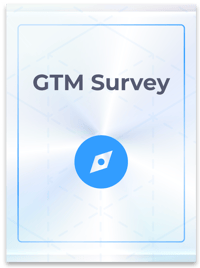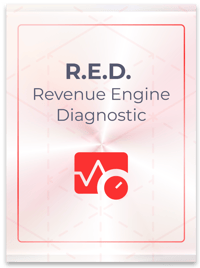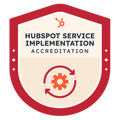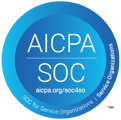Most sales pipelines are set up for failure
Tools aren't the problem. Disconnected systems are.
We give Sales leaders what they actually need. Deal stage clarity, rep visibility, and systems that drive revenue, not busywork.
.png?width=1129&height=1174&name=Drawing%20-%20Funnel%20(Full).png)
Sales Teams are being set up to miss quota
You’re under pressure to close more, faster -- with fewer resources and less support.
And the processes you inherited? They're working against you.
We see it all the time. And we fix it.
Why most CRMs are broken
You didn’t break it. But you’re stuck with the mess.
Most leaders inherit a CRM with:
-
smart_toy
Deal stages that don’t match reality
-
database_off
Properties no one uses (but everyone’s scared to delete)
-
widgets
Reports that confuse more than clarify
-
settings_account_box
No single source of truth for pipeline or rep performance
And every “fix” adds more tools, more noise, and more overhead.
What Sales Leaders actually need
Here’s what sales leaders tell us they want.
Sales leaders need:
-
database
Deal stages that match reality
-
assignment_turned_in
Reporting that reflects performance
-
visibility
Live visibility into pipeline gaps and rep activity
-
flowsheet
Systems that support enablement and capacity planning
-
robot_2
Someone else to build it (so they don't have to)
We don’t start with assumptions. We start with proof.
Before we lift a finger in your CRM, we run two foundational diagnostics:

GTM Survey: We map all of your existing GTM motions
We dig into:
- Who you’re selling to (ICP clarity)
- How Sales, Marketing, and CS define stages (and where they’re misaligned)
- Where your customer data lives and where it leaks

Revenue Engine Diagnostic: Your RevOps MRI
The RED is where we:
- Funnel stage ownership across functions
- Identify broken handoffs, missing KPIs, and blind spots that sabotage visibility
- Create a tactical, 90-day roadmap to fix what’s not working
Impact
Impact
The Revenue Performance Model: See the full funnel. Finally.
Our proprietary Revenue Performance Model (RPM) maps the entire GTM journey, from first touch to expansion, so Sales can stop reacting and start optimizing.
Here’s where Sales lives in the BowTie
Select
SQL to Opportunity conversion rate.
Activate
Sales cycle length, forecast accuracy, average deal size
Impact
Closed Won, churn prevention, net revenue retention visibility
What we unlock
- Deal flow visibility across every stage
- Forecast vs. actual
- Win rate by source and stage
- Deal value trends
- Insights into velocity, value, and conversion breakdowns
SalesOps playbooks that drive results
We build in-CRM playbooks that:
- Define deal stages and exit criteria
- Automate workflows for stage progression
- Train reps on what to do and when
- Provide Sales Managers with the views and reports they actually need
Some of the playbooks built for Sales include:
Sales Stages
What is a Sales Process?
- Definition: A repeatable roadmap that guides the sales process through the buyer journey in “stages”.
- Deal Pipelines: Deal pipelines help visualize your sales process to predict revenue and identify selling roadblocks.
- Deal Stages: Deal stages are the steps in your pipeline that signify to your sales team that an opportunity is moving toward the point of closing.
- Each deal stage represents a different step of that customer's journey with your sales team, from their first discovery call to signing the quote.
- Deal Stages can also help provide important data about the health of your pipeline.
Why it Matters
Standardization creates:
- A strong sales process helps reps consistently close deals by giving them a framework to follow.
- More accurate forecasting
- A decrease in onboarding time
- A way to ID best reps and train on their strategies
- Better content for each stage
- A way to see Sales leakage via rep performance or process issues
- A process for escalating critical deals
Sales Capacity Model
What is it?
A complete Sales Capacity Model that maps rep-level productivity, ramp time, attrition, and hiring plans to revenue goals, enabling you to make informed headcount decisions for the next 4 quarters and beyond
Why it Matters
- Reality Check: Shows when revenue goals outrun current head-count or pipeline.
- Clear Hiring Triggers: Flags the exact month new seats must open, factoring ramp and recruit lag.
- Shared Truth: Gives Sales, RevOps, and Finance one math source instead of three spreadsheets.
- Scenario Safety: Lets leaders test best, base, and worst cases before they spend.
- Rep Coverage: Do we have enough tenured and ramping reps to hit target?
- Deal Load: How many active deals can one rep manage without burnout?
- Hiring Timing: When do we need to add seats, given 60-90-day recruiting and ramp?
- Ramp & Attrition: How do new-hire ramp curves and expected churn affect capacity?
- KPI Shifts: What happens if win rate falls or average deal size drops 10 %?
Other Use Cases
- Customer Success (CS): Model CSM/PX coverage based on accounts per rep, customer segmentation, or revenue-managed per CSM/PX. Helps determine if current headcount can support expansion or renewals goals.
- Sales Engineering (SE): Forecast SE staffing needs based on expected deal volume, AE-to-SE ratios, or demo hours required per opportunity. Ensures adequate technical coverage for scaling sales motions.
- Customer Support: Use ticket volume trends and response time SLAs to model support agent capacity. Helps ensure service levels are maintained as the customer base grows.
- Implementation/Delivery Teams: Model capacity based on average onboarding hours per customer, project complexity, and hours availability. Useful for scaling services teams as deal volume increases.
Forecasting & Goals
What is it?
-
Definition: Get a holistic overview of your entire pipeline and quickly dive into the details with your team. See how your quarter is going and inspect deals to make sure your team is on track.
Why it Matters
- Informed Decision-Making: Accurate forecasts enable you to make strategic decisions that drive business growth.
- Revenue Tracking: By tracking goals across multiple pipelines, you ensure that revenue targets are met and can adjust strategies as needed.
- Deal Management: Forecast categories help you group deals by their likelihood to close, improving pipeline management and sales efficiency.
- Enhanced Team Performance: Setting clear goals and tracking progress keeps teams aligned and motivated to achieve targets.
- Set-up Forecast Category: Forecast categories will allow you to group your deals into categories that represent a deal's likelihood to close
Sales Sequences
What is it?
- A sales sequence, also referred to as a sales cadence, is a scheduled series of sales touch-points that include phone calls, emails, social messages, and LinkedIn messages, as well as other tasks that are delivered at a pre-defined interval over a particular period of time.
- The goal of a sales sequence is to generate a conversation with qualified prospects and set meetings for further discussions. Typically, sales development reps use sequences to schedule and manage their outreach to leads and prospects. However, account executives also use sequences to keep in touch with contacts leading up to, and following demos.
Why it Matters
- Sales sequences establish activities and timing, which eliminates all guesswork so salespeople always know what do to next and can continually advance each prospect without missing a beat.
- They also leverage approved email templates so that individuals don't need to come up with all email content themselves
- Sequences also establish standards and best practices for your sales team. This means that the outcomes and effectiveness of outreach patterns and messaging can be measured and optimized for success.
- These can help you set up a standardized process for how the sales team reached out to cold outbound prospects as well as inbound prospects through form a submission. You can also automate task assignment to make sure each sales rep does the same process each time.
Proposals & Quotes
What is it?
- Definition: The process by which companies send quotes and collect payment via HubSpot.
Revenue Performance Model + Quotes Crossover

- Quotes are used at select phase of the RPM model.
- Quotes are also required at Activate, Impact & Expand phases.
- Once the contact has deal associated with, in later deal stages when prospect has chosen product/services & negotiated on Terms & Conditions & pricing, Quotes are sent to prospects for signing that quote.
- At Select Phase quotes are sent to prospect to sign & prospect becomes a customer once they have paid that quote at activate phase. Designing a Quotes Process becomes very critical, because if
- If the quotes process is slow or confusing, prospects may lose interest or turn to competitors.
- Errors in the quoting process can lead to incorrect pricing, which may result in financial losses or disputes with customers.
- Inconsistencies in the design and content of quotes may impact the organization's brand image and professionalism.
- At Impact & Expand phase, quotes become very important, because there might be situation of Upgrades & Downgrades at this phase, When this situation arises Quote process have to be aligned with prospect requirements.
Target Accounts
What is it?
- It's a centralized command center for your Key accounts if you have a team that needs to be laser-focused on those (i.e enterprise sales teams)
- It helps cut through the noise and see the big picture of all selected key accounts & the granular picture of individual key account
Features
- Categorizing deals using tags and designating target accounts, users can easily identify and prioritize important accounts.
- The customization options allow businesses to tailor the software to their specific requirements.
- The pre-built reports and metrics provide valuable insights into the progress and effectiveness of target account management.
- Additionally, the disqualification of closed deals from the target account system ensures that users can focus on active accounts and maximize their sales efforts.
Pre-Sales - SQL Expansion
What is it?
- A second layer pipeline that serves a specific purpose: Expand on what's going on pre-sale (SQL) and enable a granular measure of what you have on the Opportunity level.
Why it Matters
- Standard SDR Process works mostly on the company/contact object where the information can get lost easily with no enforcement, conversion or accountability to measure and improve
- To enable Revenue Teams (SDRs, AEs, Etc) to go granular on what's going on at the Lifecycle Stage: SQL
- To ensure smooth hand-off in 2 Stage motion orgs between SDRs/BDRs ➝ AEs with valuable information intact and not lost on company/contact level
- To uncover deeper insights on what's going on before the pipeline is even created, like why was the pipeline NOT created for X contact/company.
Sales Weekly Review Dashboard
What is it?
A comprehensive reporting dashboard to run weekly meetings with your Sales team covering forecasts, pipeline, activities, and leaderboard standings.
Why it Matters
- Use to monitor rep performance:
- Forecasting: Is the team going to hit quota?
- Behaviors: Are reps doing the right thing?
- Competition: Encourage competition among peers
Leads & Meetings Routing
What is it?
- Reduce manual intervention in lead assignments, minimizing potential errors and delays.
- Enhance the efficiency of the sales process by ensuring leads are promptly and accurately directed to the appropriate sales representatives.
- Optimize resource allocation, leading to improved sales performance and a better experience for both the sales team and prospects.
End-State
- Automated Lead Assignment: Leads are automatically assigned to the most suitable sales representatives based on predefined criteria, such as geographic region, product interest, or company size.
- Efficient Meeting Scheduling: Prospects can seamlessly schedule meetings with the appropriate sales reps immediately after submitting a form, eliminating back-and-forth communications and reducing the time to initial contact.
- Balanced Workload Distribution: The system ensures an even distribution of leads among sales reps to prevent overload on any single team member and promote a fair and manageable workload.
- Enhanced Sales Productivity: With reduced manual tasks and clear assignment protocols, sales reps can focus more on engaging with prospects and closing deals, which in turn would lead to increased productivity and morale.
- Improved Data Accuracy: Automated processes reduce the likelihood of errors in lead assignment and tracking, resulting in more reliable data for analysis and decision-making.
Why it Matters
- Increased Sales Velocity: Faster lead response times can significantly boost conversion rates, as timely engagement often correlates with higher success in closing deals.
- Enhanced Sales Productivity: By automating routine tasks, sales reps can dedicate more time to high-value activities, such as personalized outreach and relationship building.
- Improved Data Accuracy: Automation minimizes manual data entry errors, ensuring that lead information is accurate and up-to-date, which is vital for effective follow-up and reporting.
- Superior Customer Experience: Prospects benefit from prompt responses and interactions with the most appropriate sales reps, leading to a more positive perception of the company and its services.
- Cost Efficiency: By leveraging HubSpot's native functionalities, businesses can reduce reliance on external tools, potentially lowering costs and simplifying system integrations.
Sales wins you can't ignore
Challenge: Pre-sales lead tracking lacked insight
Solution: Rebuilt with same-object associations
Impact: Greater precision in SQL-to-Opp tracking
Challenge: Pre-sales lead tracking lacked insight
Solution: Rebuilt with same-object associations
Impact: Greater precision in SQL-to-Opp tracking

Challenge: Lack of sales performance visibility
Solution: HubSpot implementation, system consolidation
Impact: Standardized process, improved tracking
Challenge: Lack of sales performance visibility
Solution: HubSpot implementation, system consolidation
Impact: Standardized process, improved tracking
Challenge: Global sales team couldn’t align
Solution: Optimized sales processes and demo scheduling
Impact: 36% conversion lift QoQ
Challenge: Global sales team couldn’t align
Solution: Optimized sales processes and demo scheduling
Impact: 36% conversion lift QoQ

Challenge: Siloed sales and marketing
Solution: HubSpot migration with full pipeline visibility
Impact: Faster workflows, stronger sales coordination
Challenge: Siloed sales and marketing
Solution: HubSpot migration with full pipeline visibility
Impact: Faster workflows, stronger sales coordination

Challenge: Tangled pipeline, limited reporting
Solution: Scalable architecture in Sales Hub Enterprise
Impact: Better sales operations, better forecasting
Challenge: Tangled pipeline, limited reporting
Solution: Scalable architecture in Sales Hub Enterprise
Impact: Better sales operations, better forecasting
We're the RevOps Team you wish you hired sooner
Hiring RevOps in-house?
Good luck finding someone who can:
- Architect your CRM
- Own your workflows
- Build your reports
- Align with GTM strategy
And if they leave? You’re back to square one.
We give you a full RevOps department:
RevOps Strategists
Align GTM to RevOps strategy
CRM Technologists
Build the workflows and systems
Playbooks + Data Analysts
HubSpot/RevOps best practices
HubSpot accreditations that drive sales results
As a HubSpot Elite Partner, we have the credentials and expertise to help your sales team achieve real, measurable results.
Here’s how we back it up:

RevPartners gives you access to the best possible talent in the HubSpot ecosystem. We've done the work. Now let us show you.

Less than 1% of HubSpot Partners achieve Elite status. RevPartners is the fastest to do it. Ever.

CRM Implementation Accreditation

Solutions Architecture Design

Platform Enablement Accreditation

Custom CRM Integration Accreditation

HubSpot Onboarding Accreditation

HubSpot CRM Data Migration Accreditation

Service Hub Implementation Accreditation

Platform Excellence Impact Award Winner

AICPA SOC 1 and SOC 2 Certified
Close more. Stress less.
Sales leaders don’t want to run RevOps. They want it to run for them.
Because the sooner your CRM stops fighting you, the faster you can scale your team, hit your number, and keep your seat.









